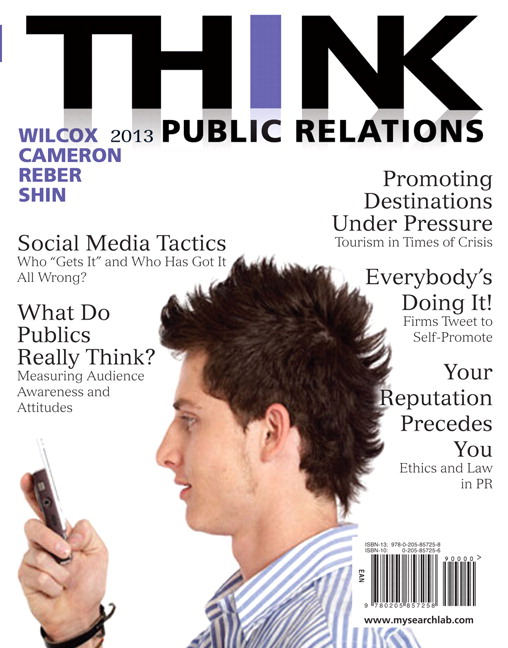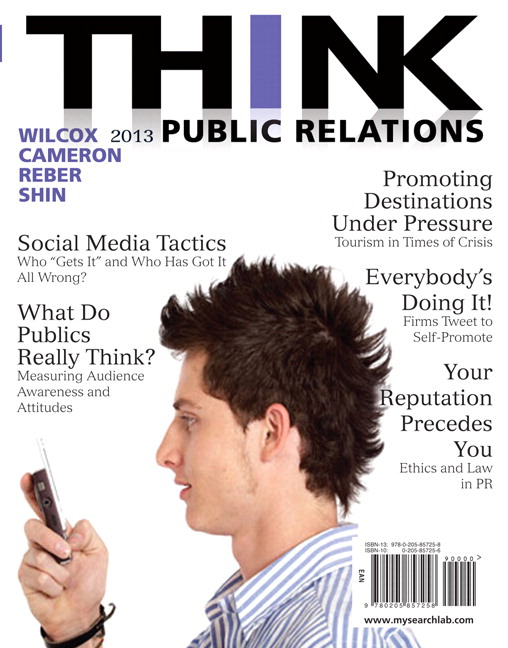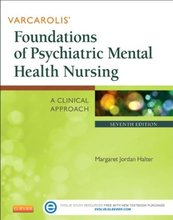This is completed downloadable of Test Bank for THINK Public Relations, 2/E 2nd Edition

Product Details:
- ISBN-10 : 9780205857258
- ISBN-13 : 978-0205857258
- Author:
The engaging visual design of THINK Public Relations provides an introduction to the field of public relations that successfully blends theory and practice in an easy-to-read format. Students are introduced to exciting and innovative public relations campaign examples in the contract of relevant theory and core concepts that they will need to succeed in the world of public relations. The authors offer a practical approach to the study of public relations and emphasize competition and conflict management, while providing a concise, comprehensive overview of the profession.
A better teaching and learning experience
This program will provide a better teaching and learning experience―for you and your students. Here’s how:
- Improve Critical Thinking―Questions and cases throughout the text encourage students to think critically about public relations topics.
- Engage Students―An appealing visual design and real-world applications engage students in the material.
- Apply Ethics― Feature boxes introduce readers to the important ethical and legal issues facing public relations practitioners today.
Table of Content:
- 1 What is Public Relations?
- Ask Yourself
- A Busy Day
- The Challenge of Public Relations
- Think
- Global Scope
- A Variety of Definitions
- Think
- Public Relations as a Process
- Think
- The Components of Public Relations
- How Public Relations Differs from Journalism
- Scope
- Objectives
- Audiences
- Think
- Channels
- How Public Relations Differs from Advertising
- Think
- How Public Relations Differs from Marketing
- Toward an Integrated Perspective: Strategic Communication
- Summary
- What Is Public Relations? p. 3
- What Are the Components of Public Relations? p. 10
- How Does Public Relations Differ from Journalism? p. 12
- How Does Public Relations Differ from Advertising? p. 14
- How Does Public Relations Differ from Marketing? p. 15
- How Can an Integrated Approach to Public Relations Benefit an Organization? p. 17
- Questions for Review and Discussion
- 2 Careers in Public Relations
- Ask Yourself
- “Robust” and Increasingly Integrated
- A Changing Focus in Public Relations
- Think
- Personal Qualifications and Attitudes
- Six Essential Abilities
- Think
- Week 1
- Week 2
- Week 3
- Week 4
- Week 5
- Week 6
- The Importance of Breadth and Depth of Knowledge
- Good Writing
- Intelligence
- Cultural Literacy
- The Ability to Recognize a Good Story When You See One
- Media Savvy
- Contacts
- Good Business Sense
- Broad Communications Experience
- Specialized Experience
- Fresh Perspective
- Organizational Roles
- The Value of Internships
- Think
- Salaries in Public Relations
- Entry-Level Salaries
- Salaries for Experienced Professionals
- Think
- Salaries for Women: The Gender Gap
- An Overview of Salaries in the Public Relations Field
- The Value of Public Relations
- Think
- Summary
- How Is the Field of Public Relations Changing? p. 26
- Which Personal Qualifications, Attitudes, and Abilities Help Professionals Succeed in Public Relations? p. 28
- What are the Different Job Levels and Roles in Public Relations Practice? p. 33
- How Much Do Public Relations Professionals Earn? p. 35
- Questions for Review and Discussion
- 3 The Growth of a Profession
- Ask Yourself
- The Advancement of Women
- A Brief History of Public Relations
- Ancient Beginnings
- Think
- Public Relations in Colonial America
- The Age of the Press Agent
- Public Relations Grows as America Grows
- The Rise of Politics and Activism
- Modern Public Relations Comes of Age
- Think
- Public Relations Expands in Postwar America
- Evolving Practice and Philosophy
- Press Agentry/Publicity
- Public Information
- Two-Way Asymmetric
- Two-Way Symmetric
- Think
- Trends In Today’s Practice of Public Relations
- Feminization of the Field
- Think
- The Importance of Diversity
- Other Major Trends in Public Relations
- A Growing Professional Practice
- The Public Relations Society of America
- Think
- The International Association of Business Communicators
- The International Public Relations Association
- Professionalism, Licensing, and Accreditation
- Professionalism
- Licensing
- Think
- Accreditation
- Keeping an Eye on Trends
- Summary
- Which Key Events and Individuals Shaped the History of Public Relations? p. 44
- What Are the Trends in Today’s Practice of Public Relations? p. 55
- In What Ways Is Public Relations Evolving and Growing as a Professional Practice? p. 61
- What Are the Major Professional Public Relations Organizations and What Do They Do? p. 62
- Questions for Review and Discussion
- 4 Today’s Practice: Departments and Firms
- Ask Yourself
- Texting Program Reaches Out to Mothers
- Public Relations Departments
- Organizational Factors Determine the Role of Public Relations
- Think
- How Public Relations Departments Are Organized
- Think
- Line and Staff Functions
- Levels of Influence
- Sources of Friction
- The Trend Toward Outsourcing
- Public Relations Firms
- Think
- Global Reach
- The Rise of Communication Conglomerates
- Think
- Think
- Structure of a Counseling Firm
- Pros and Cons of Using a Public Relations Firm
- Fees and Charges
- Which Offer?
- Summary
- Which Factors Determine the Roles and Status of Public Relations Departments in an Organization? p. 70
- Which Levels of Influence Can Public Relations Departments Exercise in an Organization? p. 73
- Which Services Do Public Relations Firms Provide? p. 79
- What Are the Pros and Cons of Employing a Public Relations Firm? p. 83
- Questions for Review and Discussion
- 5 Research and Campaign Planning
- Ask Yourself
- Tapping Into Research Helps Ensure Success
- The Four Essential Steps of Effective Public Relations
- Research: The First Step
- Many questions should be asked before formulating a research design:
- Achieving Credibility with Management
- Defining Audiences and Segmenting Publics
- Think
- Formulating Strategy
- Testing Messages
- Preventing Crises
- Monitoring the Competition
- Generating Publicity
- Measuring Success
- Research Methods
- Research Techniques
- Think
- Scientific Sampling Methods
- Think
- Reaching Respondents
- Questionnaire Guidelines
- Planning: The Second Step
- Approaches to Planning
- Think
- The Eight Elements of a Program Plan
- Research
- Action
- Communication
- Evaluation
- Think
- Plan for Success
- Summary
- What Are the Four Essential Steps of Effective Public Relations? p. 90
- How Is Research Used in Public Relations? p. 90
- How Is Research Conducted in Public Relations? p. 94
- What Role Does Planning Play in Effective Public Relations? p. 103
- What Are the Eight Elements of a Program Plan? p. 103
- Questions for Review and Discussion
- 6 Communication and Measurement
- Ask Yourself
- An Interesting Campaign for a “Most Interesting” Beer
- Communication: The Third Step
- The Goals of Communication
- Making Sure the Audience Receives the Message
- Think
- Schramm’s Expanded Model
- Making Sure the Audience Pays Attention to the Message
- Making Sure the Message Is Understood
- Making the Message Credible
- Think
- Think
- Making the Message Memorable
- Use Symbols, Acronyms, and Slogans
- Avoid Jargon
- Avoid Clichés and Hype Words
- Avoid Euphemisms
- Avoid Discriminatory Language
- Making Sure the Audience Acts on the Message
- Measurement: The Fourth Step
- Think
- Objectives: A Prerequisite for Measurement
- Basic Measurement Questions:
- Measurement and Evaluation Status
- Measurement of Message Exposure
- Media Impressions
- Internet Hits
- Advertising Equivalency
- Systematic Tracking
- Information Requests
- Cost per Person
- Audience Attendance
- Measurement of Audience Awareness, Attitudes, and Action
- Audience Awareness
- Think
- Audience Attitude
- Audience Action
- Think
- Getting Blood from a Stone?
- Summary
- What Are the Goals of Public Relations Communication? p. 116
- Which Factors Influence Message Reception, Comprehension, Retention, Credibility, and Adoption? p. 117
- Why Is Measurement of Public Relations Program Effectiveness Important? p. 127
- Which Methods Are Used to Measure the Effectiveness of Public Relations Programs? p. 129
- Questions for Review and Discussion
- 7 Public Opinion and Persuasion
- Ask Yourself
- Going Green: Everybody’s Doing It
- What Is Public Opinion?
- Public Opinion Is a Moving Target
- Public Opinion Is Powerful
- Think
- Opinion Leaders As Catalysts
- The Role of Mass Media
- Agenda Setting
- Framing
- Think
- The Role of Conflict
- Of The 12,996 Murders Committed
- Think
- Persuasion In Public Opinion
- The Uses of Persuasion
- Persuasion and Negotiation
- Make It Clear
- Make It Easy
- Make It Popular
- Think
- Factors in Persuasive Communication
- Demographics for Key Groups
- Audience Analysis
- A Friend’s Recommendation Is MOST Trusted
- Appeals to Self-Interest
- Think
- Audience Participation
- Suggestions for Action
- Source Credibility
- Think
- Clarity of Message
- Channels
- Think
- Timing and Context
- Reinforcement
- The Limits of Persuasion
- Lack of Message Penetration
- Competing or Conflicting Messages
- Persuading Volunteers
- Self-Selection
- Self-Perception
- Think
- Summary
- What Is Public Opinion? p. 138
- Who Are Opinion Leaders? p. 140
- What Role Do the Mass Media Play in Shaping Public Opinion? p. 143
- How Does Conflict Affect Public Discourse? p. 146
- What Makes Communication Persuasive? p. 151
- What Are the Limitations of Persuasion? p. 157
- Questions for Review and Discussion
- 8 Managing Competition and Conflict
- Ask Yourself
- Good Intentions Go Further with Smart PR
- A New Way of Thinking: Conflict & Competition
- Think
- The Role of Public Relations in Managing Conflict
- Think
- Think
- It Depends: Factors that Affect Conflict Management
- The Threat Appraisal Model
- Contingency Theory
- The Conflict Management Life Cycle
- Proactive Phase
- Strategic Phase
- Reactive Phase
- Think
- Recovery Phase
- Managing the Life Cycle of a Conflict
- Think
- Issues Management
- Strategic Positioning and Risk Communication
- Think
- Crisis Communication
- Reputation Management
- Think
- Examples of Typical BP Facebook Posts
- From June 30, 2010
- From July 12, 2010
- From July 12, 2010
- Examples of Typical BP Tweets
- From August 23, 2010:
- From June 4, 2010
- From May 25, 2010
- Adversarial or Accommodative?
- Déjà Vu—All Over Again
- Summary
- What Role Do Competition and Conflict Play in Public Relations? p. 164
- What Factors Affect the Stance That an Organization Takes During Conflict Management? p. 169
- What Are the Phases of the Conflict Management Life Cycle? p. 171
- How Can Public Relations Professionals Best Manage the Conflict Management Life Cycle? p. 173
- Questions for Review and Discussion
- 9 Ethics and the Law
- Ask Yourself
- Helping a Tyrant Burnish his Image
- What is Ethics?
- Think
- Professional Guidelines
- Codes of Conduct
- Think
- Ethics in Individual Practice
- Dealing with the News Media
- Think
- Public Relations and the Law
- Defamation
- Think
- Avoiding Libel Suits
- Employee Communications
- Product Publicity and Advertising
- Employee Free Speech
- Copyright Law
- Fair Use Versus Infringement
- The Rights of Photographers and Artists
- Think
- The Rights of Freelance Writers
- Trademark Law
- The Protection of Trademarks
- Trademark Infringement
- Think
- Misappropriation of Personality
- Regulations by Government Agencies
- The Federal Trade Commission
- Think
- The Securities and Exchange Commission
- Other Regulatory Agencies
- Liability For Sponsored Events
- Working With Lawyers
- Ethics in Practice
- Summary
- Why Is Ethics a Relevant Issue for Public Relations Practitioners? p. 182
- What Do Public Relations Professionals Need to Know About Defamation, Employee and Privacy Rights, Copyright, and Trademark Laws? p. 184
- Which Guidelines and Government Agencies Govern the Commercial Speech Used by Public Relations Professionals? p. 197
- How Can Public Relations Professionals Facilitate Good Working Relationships with Lawyers? p. 200
- Questions for Review and Discussion
- 10 Reaching Diverse Audiences
- Ask Yourself
- Engaging Ethnic Audiences
- The Nature of The Public Relations Audience
- Dynamic and Segmented Audiences
- Think
- Strategic Public Relations Targets Key Audiences
- Age Group Audiences
- Youth
- Think
- Baby Boomers
- Seniors
- Gender/Lifestyle Audiences
- Women
- The LGBT (Lesbian, Gay, Bisexual, and Transgender) Community
- Religious Groups
- Ethnically Diverse Audiences
- Think
- Diversity Media
- Hispanics
- African Americans
- Global Audiences
- Think
- Matching the Audience with the Media
- Radio and Video
- Television
- Think
- Online and Social Media
- Finding Your Place in the Sun
- Summary
- How Does the Diverse Nature of Audiences Affect Public Relations Practice? p. 206
- How Can Information About the General Characteristics of Key Demographic Groups Inform Effective Public Relations Efforts? p. 210
- Why Is It Important to Match Media Type to Audience? p. 220
- Questions for Review and Discussion
- 11 The Mass Media
- Ask Yourself
- A Varied Campaign Helps Slurpee Unite America
- News Releases
- Is It Time for a News Release?
- Think
- The Standard News Release
- The Online News Release
- The Multimedia News Release
- The Content of a News Release
- Publicity Photos
- Media Advisories, Fact Sheets, Media Kits, and Pitch Letters
- Interviews with Journalists and News Conferences
- Interviews
- News Conferences
- Think
- Planning and Conducting a News Conference
- The Media Party and The Media Tour
- Think
- The Reach of Radio and Television
- Radio
- Think
- Television
- Think
- Personal Appearances
- Think
- Product Placements
- Think
- A Grand Opening
- Summary
- What Is the Role of News Releases in Public Relations? p. 226
- How Are Media Advisories, Fact Sheets, Media Kits, and Pitch Letters Used in Public Relations Campaigns? p. 230
- Which Public Relations Tactics Are Best for Reaching Television and Radio Audiences? p. 235
- How Can Product Placements Be Leveraged to Promote Products and Services? p. 241
- Questions for Review and Discussion
- 12 The Internet and Social Media
- Ask Yourself
- Tweeting the Revolution
- The Internet
- Think
- Think
- Leveraging the Power of the Internet
- Interactivity
- Think
- Cost-Effectiveness
- Webcasts, Podcasts, and Wikis
- Think
- Social Media
- Think
- Blogs
- Think
- Think
- Think
- YouTube
- Think
- The Rising Tide of Mobile-Enabled Content
- Think
- Texting
- Apps Everywhere
- Texas Tech University
- Bertolli Olive Oil
- Think
- QR Codes: Just a Scan Away
- Think
- Adding Friends and Followers
- Summary
- How Did the Internet Cause a Communications Revolution? p. 246
- Which Characteristics of the Internet Make It a Powerful Public Relations Tool? p. 247
- How Are Webcasts and Podcasts Used in Effective Public Relations? p. 249
- Which Social Media Tactics Are Used by Public Relations Professionals? p. 251
- Questions for Review and Discussion
- 13 Events and Promotions
- Ask Yourself
- Mr. Bubble Turns 50 with a Splash
- A world Filled with Meetings and Events
- Think
- Group Meetings
- In Advance
- On the Meeting Day
- After the Meeting
- Meeting Location
- Meeting Invitations
- Getting the Meeting Started
- Speakers
- Meals
- Banquets
- Think
- Receptions and Cocktail Parties
- Think
- Open houses and Plant Tours
- Think
- Things to Think About
- Major factors to consider in planning an open house:
- Conventions
- Convention Planning
- Think
- Convention Programs
- Think
- Trade Shows
- Exhibit Booths
- Think
- Press Rooms and Media Relations
- Promotional Events
- Corporate Sponsorships: Another Kind of Event
- Celebrity Appearances
- Corporate Event Sponsorship Considerations
- Promotional Event Logistics
- Plan an Awards Banquet
- Summary
- Which Planning and Logistical Steps Ensure Successful Meeting and Event Planning and Execution? p. 269
- Which Elements Must Be Taken into Consideration When Creating a Budget for a Meeting or an Event? p. 272
- Why Is the Investment in Meetings and Events Justified for Most Organizations? p. 280
- How Can Public Relations Professionals Harness Creativity to Plan and Implement Memorable and Effective Promotional Events? p. 282
- Questions for Review and Discussion
- 14 Global Public Relations
- Ask Yourself
- Bono: “PR Man” for the World’s Poor
- What Is global Public Relations?
- Think
- Public Relations Development in other nations
- Think
- International corporate Public Relations
- Think
- Language and Cultural Differences
- Think
- Foreign Corporations in the United States
- Representing U.S. Corporations in Other Nations
- Public diplomacy
- U.S. Public Diplomacy Efforts
- Think
- Foreign Public Diplomacy Efforts
- Think
- The Rise of Ngos
- Think
- Opportunities in International Work
- Think
- Promoting Turkey
- Summary
- How Is Public Relations Practice Developing Around the World? p. 289
- What Challenges do Corporations Encounter When They Conduct Business Internationally? p. 296
- What Is Public Diplomacy? p. 298
- How Has the Role of NGOs in the Global Marketplace Evolved? p. 301
- Which Career Opportunities Are Available in Global Public Relations? p. 302
- Questions for Review and Discussion
- 15 Corporate Public Relations
- Ask Yourself
- Netflix Announcements Draw Consumer Ire
- Managing corporate Reputations
- American Opinions about Big Business
- Think
- Media Relations
- Customer Relations
- Think
- Consumer Activism
- Consumer Boycotts
- Think
- DO:
- DON’T:
- Employee Relations
- Think
- Investor Relations
- Think
- Marketing Communications
- Product Publicity
- Think
- Think
- Cause-Related Marketing
- Corporate Sponsorships
- Viral Marketing
- Think
- Environmental Relations
- Corporate Philanthropy
- Think
- Preparing to Work Abroad
- Summary
- What Role Can Public Relations Play in Rebuilding Public Trust in Business? p. 309
- How Do Media Relations, Customer Relations, Employee Relations, and Investor Relations Foster Corporate Health? p. 310
- What Is Integrated Marketing Communications? p. 318
- How Do Environmental Relations and Corporate Philanthropy Have a Positive Impact on the Public Image of a Corporation? p. 324
- Questions for Review and Discussion
- 16 Entertainment, Sports, and Tourism
- Ask Yourself
- Internal and External Expectations Shape Tourism PR in Egypt
- Public Relations in Entertainment, Sports, and Tourism
- Promoting a Personality
- Think
- Think
- Promoting an Entertainment Event
- The “Drip-Drip-Drip” Technique
- Think
- Movies and Television
- Sports Publicity
- Think
- Travel Promotion
- Appeals to Target Audiences
- Think
- Tourism in Times of Crisis
- A Question of Ethics
- Summary
- Which Elements Are Essential for an Effective Personality Campaign? p. 331
- How Can a Publicity Campaign Increase Event Attendance? p. 335
- What Role Does Public Relations Play in the Sports Mania Flourishing Around the World? p. 337
- What Role Does Public Relations Play in Attracting Visitors to Destinations and Keeping Them Happy Once They Arrive? p. 341
- Questions for Review and Discussion
- Advertising Age
- 17 Government and Politics
- Ask Yourself
- NuVal and Nutrition Keys vs. the Food and Drug Administration
- Government Public Relations
- Think
- Public Information and Public Affairs
- Think
- The Federal Government
- The White House
- Congress
- Federal Agencies
- Think
- Think
- State Governments
- Think
- Local Governments
- Think
- Government Relations by Corporations
- Think
- Lobbying
- Pitfalls of Lobbying
- Think
- Grassroots Lobbying
- Election Campaigns
- Watching the Weather
- Summary
- What Are the Basic Purposes and Functions of Public Relations in Government Organizations? p. 351
- Which Public Relations Activities Do Government Organizations Engage in at the Federal, State, and Local Levels? p. 352
- What Are Public Affairs, Governmental Relations, and Lobbying? p. 360
- What Role Does Public Relations Play in Election Campaigns? p. 363
- Questions for Review and Discussion
- 18 Nonprofit, Health, and Education
- Ask Yourself
- Faith-Based Advocacy Comes of Age
- The role of Public Relations in Nonprofit, Health, and Education Organizations
- Think
- Competition, Conflict, and Cooperation
- Think
- Fund-raising
- Think
- Motivations for Giving
- Fund-Raising Methods
- Think
- Membership Organizations
- Professional Associations
- Think
- Trade Associations
- Labor Unions
- Chambers of Commerce
- Advocacy Groups
- Think
- Activist Groups
- Social Issue Organizations
- Social service Organizations
- Philanthropic Foundations
- Cultural Organizations
- Think
- Religious Organizations
- Health Organizations
- Hospitals
- Think
- Health Agencies
- Health Campaigns: Strategies and Tactics
- Educational Organizations
- Colleges and Universities
- Elementary and Secondary Schools
- Think
- School Districts
- Find the Fun
- Summary
- What Are the Basic Purposes and Functions of Public Relations in Nonprofit, Health, and Education Organizations? p. 370
- What Role Does Public Relations Play in the Fund-Raising Efforts of Nonprofit Organizations? p. 372
- Which Public Relations Goals and Tactics Do Nonprofit Advocacy Groups and Social Service Organizations Pursue? p. 379
- Which Public Relations Goals and Tactics Do Health and Education Organizations Employ? p. 383
- Questions for Review and Discussion
- Credits
- Text Credits
- Photo Credits
- Chapter 1
- Chapter 2
- Chapter 3
- Chapter 4
- Chapter 5
- Chapter 6
- Chapter 7
- Chapter 8
- Chapter 9
- Chapter 10
- Chapter 11
- Chapter 12
- Chapter 13
- Chapter 14
- Chapter 15
- Chapter 16
- Chapter 17
- Chapter 18
- Index
- A
- B
- C
- D
- E
- F
- G
- H
- I
- J
- K
- L
- M
- N
- O
- P
- Q
- R
- S
- T
- U
- V
- W
- X
- Y
- Z





